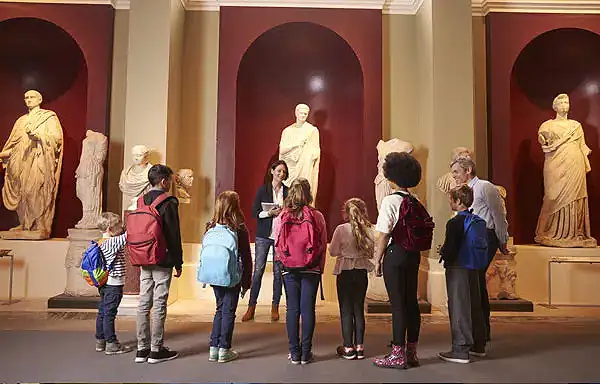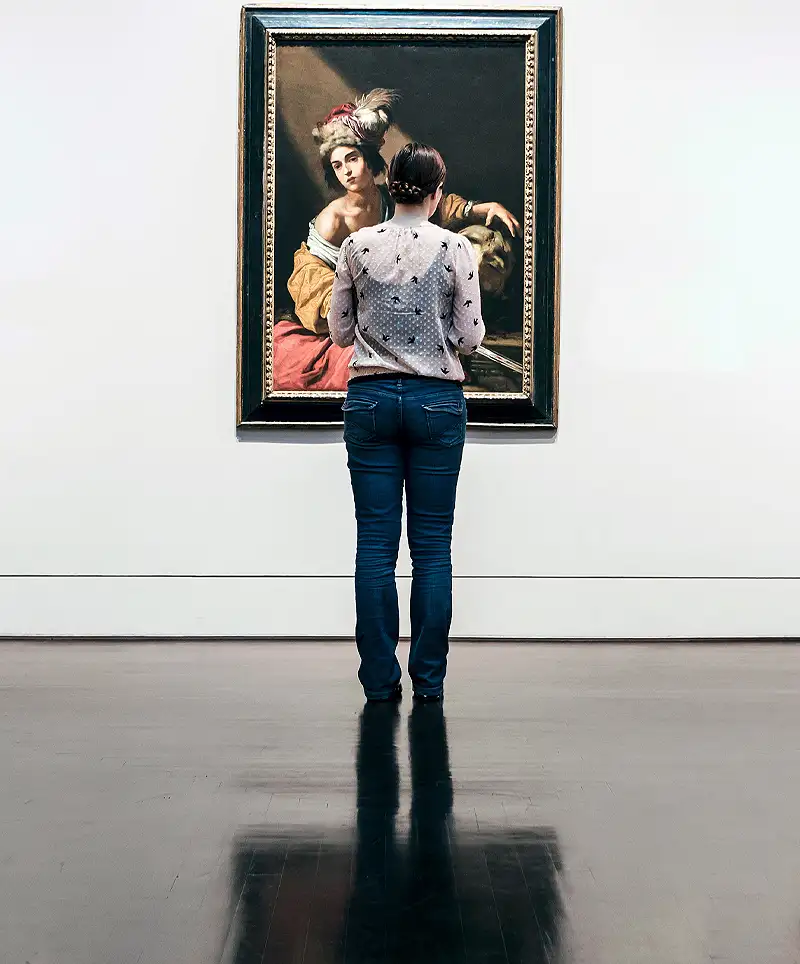Embrace the Masterpieces (and Maybe a Little Mystery)
Every year, Go To An Art Museum Day rolls around, nudging us out of our digital scrolling and into a realm of visual splendor and timeless creativity. Held annually on November 9th, it’s a chance to step out of the everyday hustle and lose ourselves in brushstrokes, sculptures, and centuries-old masterpieces. Whether you’re an art enthusiast, a history buff, or someone who just wants to enjoy the peace of staring at something that isn’t a screen, Go To An Art Museum Day is for everyone.
But what’s the big deal about art museums, and why should we carve out a day to immerse ourselves in them? Let’s dive in!
A Brief History of Art Museums
Long before art museums opened their doors to the public, art itself was a luxury reserved for royalty, the wealthy elite, and the powerful clergy. In ancient times, only the privileged had access to artistic creations, often stored in private chambers or palace galleries. Artworks were commissioned to display power, wealth, and devotion, and ordinary folks rarely had the chance to view such splendor.
The concept of the public art museum emerged during the Renaissance and Enlightenment periods, when thinkers began to champion the idea that knowledge and beauty should be shared with society at large. Art collections were displayed not just to impress but to inspire and educate.
The Louvre, originally a royal palace, set the trend in 1793 by transforming into a public museum after the French Revolution. This shift symbolized a democratization of art, allowing everyday citizens to enjoy masterpieces that once only the elite had access to. Soon after, other countries followed suit, creating national museums and public galleries that emphasized not only national pride but also a growing belief that art could enrich society.
By the 19th and 20th centuries, art museums had evolved into cultural institutions, blending education with preservation. Today, art museums are everywhere, from grand institutions like the Louvre to quirky local galleries. They’ve become not only places to view art but also spaces for dialogue, reflection, and exploration—proving that art truly belongs to everyone, no matter one’s background or level of understanding.
Why Go To An Art Museum?
Wondering why you should spend a day with art instead of binge-watching yet another show? Here are a few (slightly humorous) reasons to give it a shot:
-
It’s a Full-Body Experience (Minus the Sweating) – You’ll be walking, standing, occasionally tilting your head, and marveling at works that took lifetimes to create. Unlike the gym, though, it comes without the pressure to “do one more rep.”
-
No Art Degree Required – Forget the “I don’t understand art” excuse. Museums are for everyone, and each piece has something unique to offer. Besides, sometimes there’s no “correct” interpretation—maybe that squiggle of blue paint really does remind you of your cat’s tail.
-
A Quiet Place to Contemplate – Art museums offer a level of quiet that’s nearly extinct in today’s world. You’re allowed (encouraged, even!) to get lost in your own thoughts while pondering an artist’s choice of brushstroke or wondering why that one painting has eyes that seem to follow you.
-
Boost Your Brainpower – Studies show that experiencing art can stimulate your brain, increase creativity, and even reduce stress. Think of it as a mental massage.
-
The Perfect Date Spot – Trying to impress someone? Show off your knowledge of Renaissance painters or modernist abstraction (or make it up as you go; most people will nod politely). It’s the perfect conversation starter.
 What to Expect at an Art Museum
What to Expect at an Art Museum
So you’ve decided to go, but maybe you’re not sure what awaits you beyond the ticket booth. Fear not! Here’s a glimpse of what you might encounter:
-
The Classic Masterpieces – Prepare to meet some old friends (even if you’ve never seen them in person). Whether it’s da Vinci’s Mona Lisa or van Gogh’s Starry Night, these iconic works are as recognizable as they are awe-inspiring.
-
Modern Art Mysteries – Abstract and modern art may leave you scratching your head, but that’s half the fun! Don’t be surprised if you find a blank canvas labeled as a profound statement on human existence. Embrace the mystery and remember that art is subjective—your interpretation is just as valid as anyone else’s.
-
The Gift Shop Temptations – Don’t be ashamed if you leave the museum with a Van Gogh tote bag or a Monet mug. Art museums know how to merchandise, and before you know it, you’re walking out with your very own souvenir version of a priceless masterpiece.
How to Appreciate Art (Even if You Don’t Know What You’re Looking At)
Appreciating art doesn’t require a background in art history. In fact, there’s a certain beauty in approaching each piece with an open mind. Here are some tips for getting the most out of your art museum experience:
-
Give Each Piece a Moment – Sometimes, the first impression doesn’t do a piece justice. Pause for a few moments, let your mind wander, and see what thoughts or feelings come up.
-
Read the Descriptions (But Don’t Overdo It) – Those little plaques can tell you a lot, from the artist’s background to the era’s political climate. But sometimes it’s more fun to let your own imagination fill in the blanks.
-
Engage in a Little People-Watching – Look around and notice how other people react to the art. The expressions of awe, confusion, and deep concentration are all part of the museum experience.
-
Trust Your Gut – Art is supposed to make you feel something, even if it’s “Huh, I could’ve made that.” If you love it, great! If you don’t, that’s okay too. Art museums are filled with endless styles and eras—there’s something for everyone.
-
Ask Questions – If you’re genuinely curious, some museums have docents or audio guides that provide a deeper insight into what you’re looking at. Just make sure your questions don’t sound like “Is this supposed to be a dog or…?”
Top Museums to Visit (Even if Only Once)
For those lucky enough to be near one, there are a few legendary art museums that should be on everyone’s bucket list:
- The Louvre, Paris – Housing the Mona Lisa and countless other treasures, the Louvre is as overwhelming as it is spectacular.
- The Vatican Museums, Vatican City – Famous for Michelangelo’s Sistine Chapel, this museum is a must-see for Renaissance lovers.
- The Metropolitan Museum of Art, New York – Fondly known as “The Met,” this museum offers something for everyone, from ancient artifacts to modern art.
- The Uffizi Gallery, Florence – Home to Botticelli’s The Birth of Venus and other Renaissance gems.
- The Getty Center, Los Angeles – With art, architecture, and stunning views, this museum is an aesthetic experience from start to finish.
A Few Fun Facts About Art Museums
-
The Louvre is So Big It Could Take You Days to See Everything – It’s said that if you spent 30 seconds looking at each piece in the Louvre, it would take you over three months to see it all. Bring comfortable shoes.
-
Art Heists Happen (More Often Than You’d Think) – Art is valuable, and there’s no shortage of daring heists that have targeted museums worldwide. If you’ve seen Ocean’s 12, you know what we’re talking about.
-
Some Museums Are “Living” Museums – Not all art is on the walls. Some museums include performance art, where you might stumble upon a live, interactive installation.
At its heart, Go To An Art Museum Day isn’t only about looking at beautiful things; it’s about opening your mind, sparking curiosity, and finding moments of awe in a fast-paced world. Art museums remind us that there’s more to life than just facts and figures; there’s a whole universe of human expression waiting to be discovered.
So, take a break from your daily routine, grab a friend or two, and head to your nearest museum. Stand in front of that strange abstract sculpture or peer into the eyes of a centuries-old portrait. You never know what you might see—or feel.
And who knows? By the end of the day, you might even find yourself contemplating your own masterpiece. But until then, take Go To An Art Museum Day to appreciate the work of the masters. Because sometimes, the best way to understand art… is simply to let it move you.
Please Share our Content






 What to Expect at an Art Museum
What to Expect at an Art Museum








 "Sláinte!" is a traditional Irish expression used as a toast, equivalent to "Cheers!" in English.
"Sláinte!" is a traditional Irish expression used as a toast, equivalent to "Cheers!" in English.